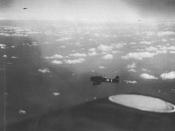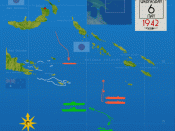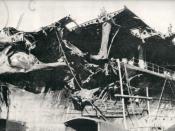In the spring of 1942, Japan's leaders faced a dilemma. Their conquest had progressed faster than expected; the problem was what to do next.
Some military leaders suggested that Japan strike the wartorn British Empire in India and the Middle East, then link up with German forces in Southern Russia and North Africa. Take Australia, counseled the Japanese Navy, this was the obvious starting point for an Allied counterattack.
The Army opposed both ideas. Japan's ground troops were already stretched thin. Either campaign would weaken them even more. In early March, a less grandiose plan was accepted. Japan would extend its empire southeast, cutting the sea lanes between Australia and America by seizing the islands of New Guinea, New Caledonia, Fiji and Samoa. The first srep was the capture of port Moresby, a key Allied base on the south coast of New Guinea, 400 miles from Australia.
For two months, Japan strengthened its bases in the area, especially Rabaul on the island of New Britain.
By May 4, a formidable naval force had been amassed, and the 11 transports destined for Port Moresby headed south from Rabaul.
The move didn't surprise Admiral Chester Nimitz, commander of the U.S. Pacific Fleet. U.S. cryptoanalysts had broken the Japanese naval code and Nimitz already had sent two carriers - the Lexington and Yorktown - to the Coral Sea to stop the Japanese. The battle that followed would be epochal: the first naval engagement in which the opposing ships never fired a shot at each other.
Japan's campaign began with an invasion of the small island of Tulagi. The U.S. struck back quickly with planes from the Yorktown. Overzealous pilots sent back exaggerated reports of the numbers of warships they'd sunk. In reality, little damage was done, but the Japanese now knew that U.S.



Coral Sea
This is probably one of the best essays I've read on the events that unfurled at Coral Sea. Judging from the number of words (997), I'm assuming that it was 1000 word limit, thus you couldn't fit in ALL the events that took place. However, this is a very thorough and well structured essay and I recommend people who are doing an essay on this subject to use this as a guide.
2 out of 2 people found this comment useful.